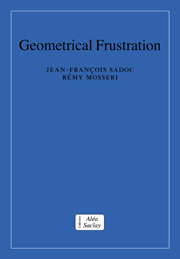Book contents
- Frontmatter
- Contents
- Preface
- 1 Introduction to geometrical frustration
- 2 Ideal models
- 3 Finite structures
- 4 Decurving and disclinations
- 5 Hierarchical polytopes
- 6 Some physical properties
- 7 Periodic structures with large cells
- 8 Quasiperiodic order and frustration
- A1 Spaces with constant curvature
- A2 Quaternions and related groups
- A3 Hopf fibration
- A4 Polytopes and honeycombs
- A5 Polytope {3, 3, 5}
- A6 Frank and Kasper coordination polyhedra
- A7 Quasiperiodic tilings: cut and projection
- A8 Differential geometry and parallel transport
- A9 Icosahedral quasicrystals and the E8 lattice
- Bibliography
- Index
2 - Ideal models
Published online by Cambridge University Press: 06 January 2010
- Frontmatter
- Contents
- Preface
- 1 Introduction to geometrical frustration
- 2 Ideal models
- 3 Finite structures
- 4 Decurving and disclinations
- 5 Hierarchical polytopes
- 6 Some physical properties
- 7 Periodic structures with large cells
- 8 Quasiperiodic order and frustration
- A1 Spaces with constant curvature
- A2 Quaternions and related groups
- A3 Hopf fibration
- A4 Polytopes and honeycombs
- A5 Polytope {3, 3, 5}
- A6 Frank and Kasper coordination polyhedra
- A7 Quasiperiodic tilings: cut and projection
- A8 Differential geometry and parallel transport
- A9 Icosahedral quasicrystals and the E8 lattice
- Bibliography
- Index
Summary
A unified approach to very different materials
It is not a priori surprising that an approach whose nature is mainly geometrical can describe very different materials, like metallic and covalent solids, amphiphilic molecules, cholesteric blue phases, etc …. As far as crystals are concerned, ‘mathematical’ crystallography takes this role of classifying all the possible structures compatible with periodicity in space, without regard to the chemical nature of the atoms. The physicist enters the field in order to relate an experimental pattern, usually the result of a diffraction experiment, to one of the possible periodic arrangements. This is already an idealization in the sense that most of the studied materials are only imperfect crystals, containing many types of defect. A perfect crystal is impossible for the first reason that it is necessarily limited in size. As is well known now, atoms close to the surface rearrange for the sake of energy minimization. A second reason is temperature: when T is finite, vacancies can contribute to configurational entropy. But standard, bulk diffraction is usually blind to these alterations of the periodic order. A natural and unavoidable obstacle to a precise structural determination is the experimental precision. The wave probes (X-rays, electrons, neutrons) have limited wave vectors, which introduce cut-like effects in the passage from reciprocal to real space.
This may not be important for simple crystals, but can prevent a precise determination for crystals with large unit cells.
- Type
- Chapter
- Information
- Geometrical Frustration , pp. 14 - 44Publisher: Cambridge University PressPrint publication year: 1999

